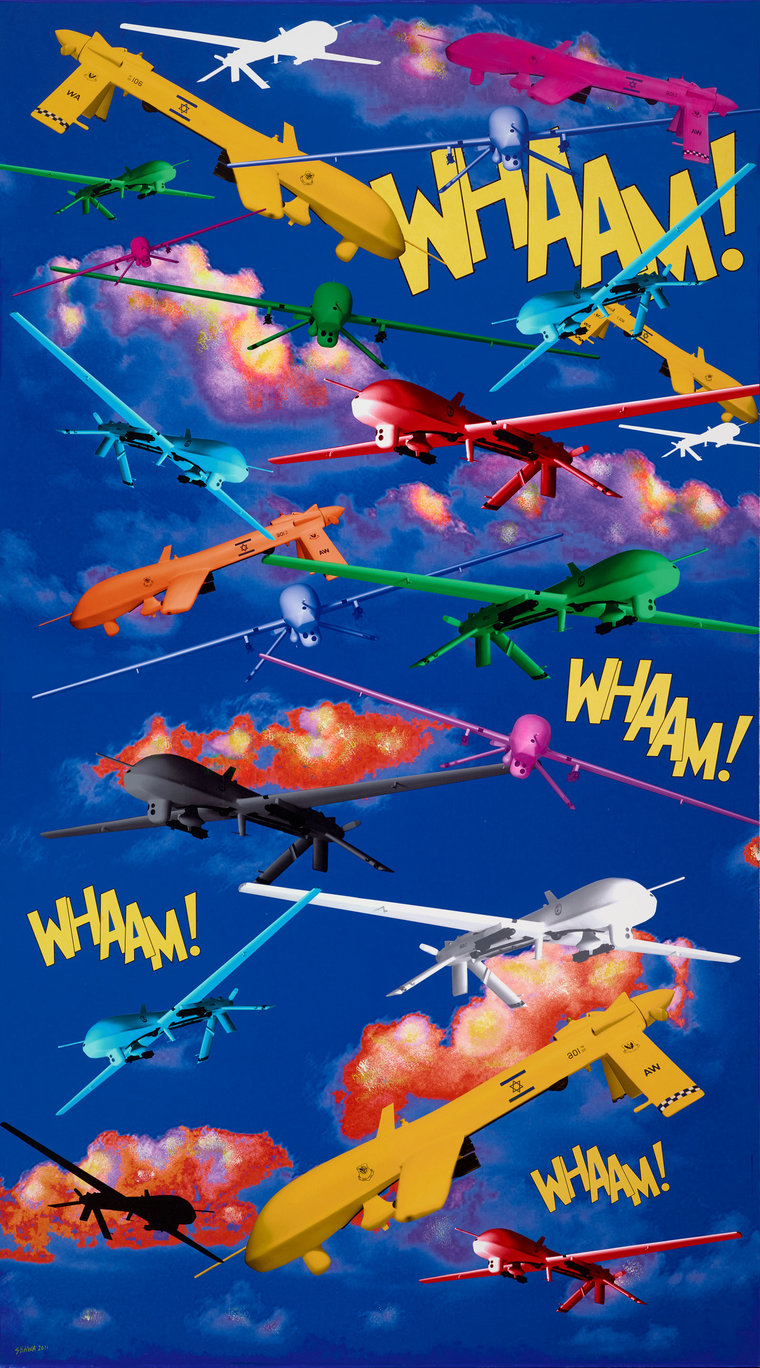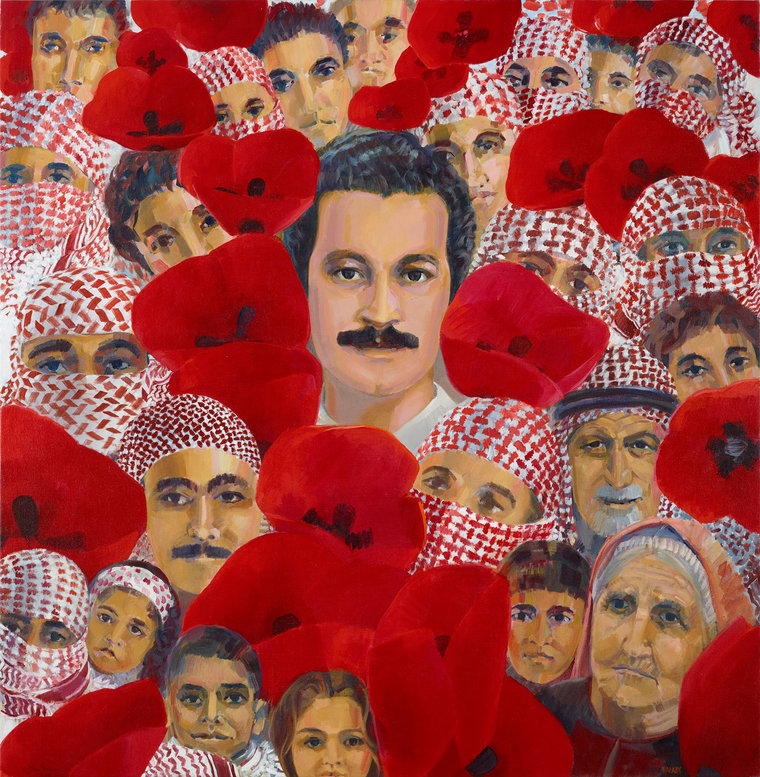Laila Shawa, a prominent artist born in 1940 into a wealthy Gazan family, embarked on a remarkable journey that intertwined her passion for art with a fervent commitment to social and political engagement. Her artistic career, marked by colorful experimentation and unwavering advocacy, serves as a testament to her resilience and determination in navigating the complexities of her identity and environment.
Shawa’s artistic odyssey commenced in the mid-1950s amidst a fortuitous encounter over tea with her father and a family friend. Despite being enrolled in political science and sociology at the American University of Cairo, Shawa’s exceptional drawing skills caught the attention of an architect friend, prompting a pivotal suggestion to pursue art education at the Leonardo Da Vinci School of Art in Cairo. With her father’s support, Shawa embarked on a transformative path that would shape her future as an artist.
Following her initial year at the Leonardo Da Vinci School, Shawa further honed her skills at the School of Fine Arts in Rome, earning a BA with honors in 1960. Her quest for artistic mastery led her to the Scuola di Arti Ornamentali San Giacomo in Rome, where she delved into plastic and decorative arts, enriching her repertoire. Notably, she sought inspiration from summer courses with Austrian expressionist Oskar Kokoschka in Salzburg, further enriching her artistic vision.
Returning to Gaza in 1965, Shawa assumed a pivotal role as a supervisor for the UNRWA arts and crafts education division, advocating for artistic expression amidst tumultuous times. Her dedication extended to lecturing at the UNESCO Institute of Education, underscoring her commitment to nurturing creativity and knowledge dissemination.
In 1968, Shawa relocated to Beirut, embracing a full-time artistic pursuit until the outbreak of the Lebanese civil war in 1975. Amidst the ensuing turmoil, she navigated between London and Gaza over the next twelve years, devoting herself to realizing the Rashad Shawa Cultural Center’s vision in Gaza, named after her father. Despite facing numerous setbacks, including occupation and bombardment, Shawa’s unwavering determination to establish a haven for artistic expression underscores her enduring optimism and resilience.
Throughout her illustrious career, Shawa’s artistic endeavors transcended conventional boundaries, encompassing diverse mediums ranging from oil paintings to fashion mannequins adorned with intricately arranged rhinestones. Central to her artistic expression is the vibrant utilization of color, juxtaposing jovial tones with thought-provoking subject matters.
One of Shawa’s seminal works, “AKA Peace” (2012), epitomizes her commitment to social and political engagement. Transforming a decommissioned Kalashnikov machine gun into a symbol of peace adorned with gold paint, rhinestones, and plastic butterflies, Shawa challenges conventional narratives surrounding conflict and violence.


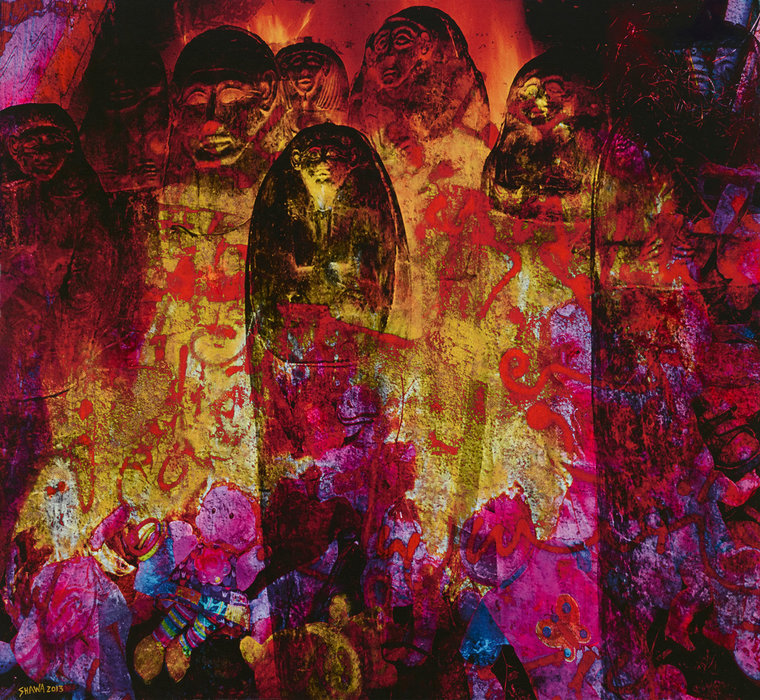
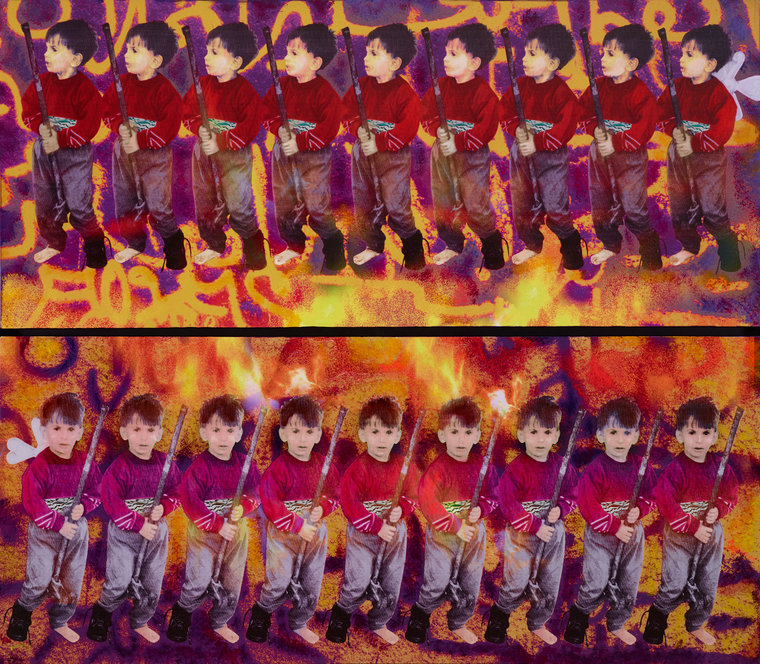

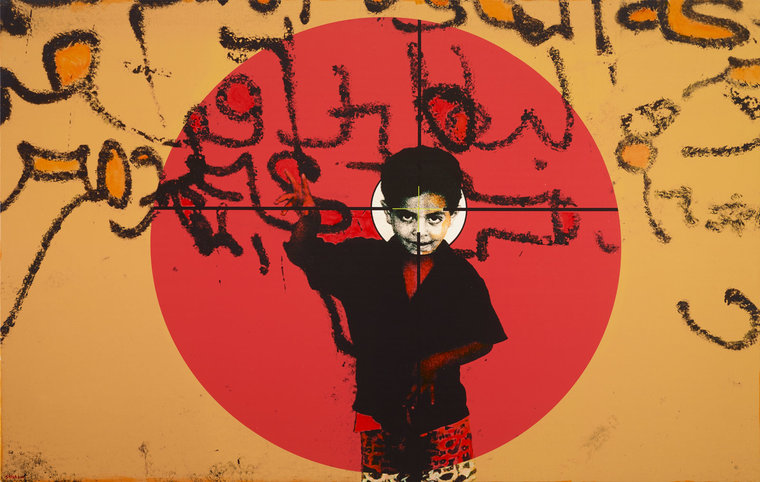
Notably, Shawa’s “Impossible Dream” series (1987-88) encapsulates her steadfast opposition to the veil’s imposition on women. Through satirical depictions of veiled women holding ice cream cones, she critiques societal norms and patriarchal structures, urging women to reclaim their agency and demand respect.
Shawa’s advocacy extends beyond artistic expression, as she vehemently denounces the veiling practice’s socio-political underpinnings. Drawing from her experiences during the First Intifada in Gaza, she underscores the intersectionality of gender and political agency, urging women to resist societal constraints and assert their worth.
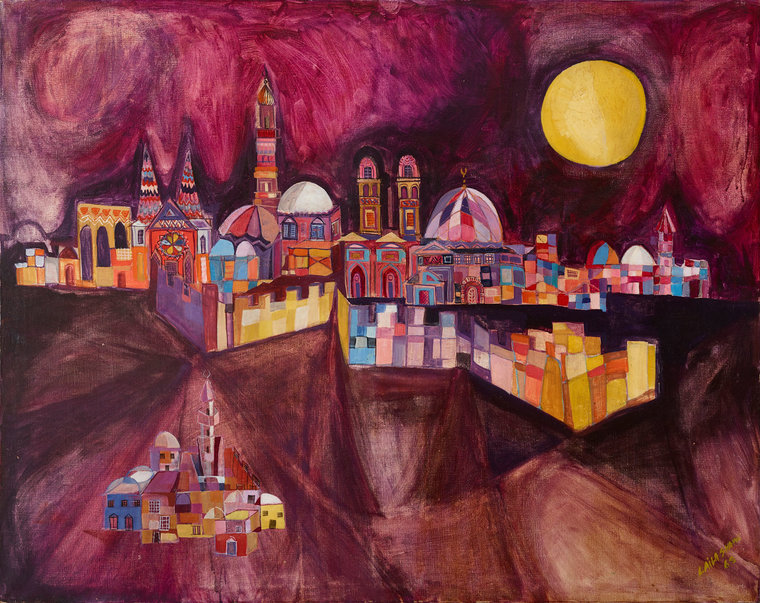
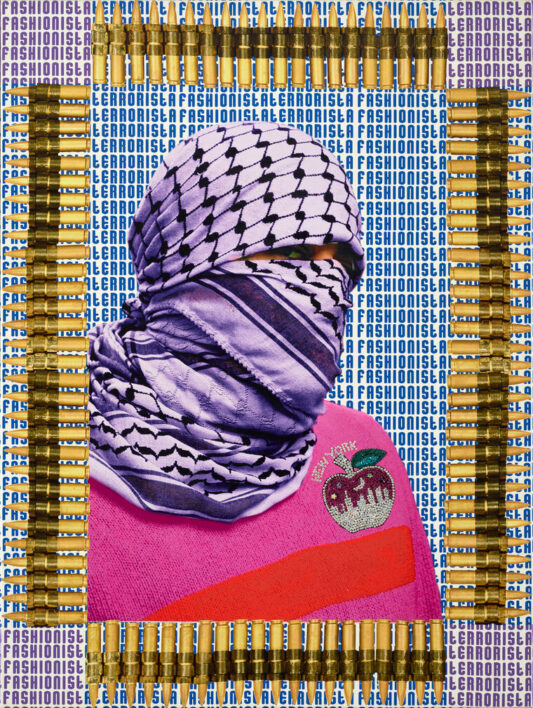


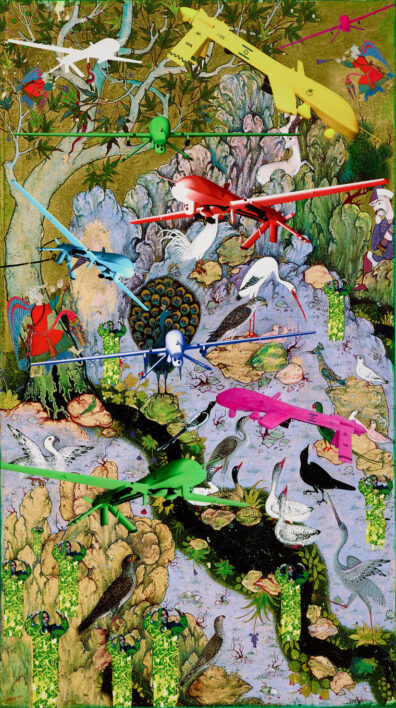

Despite residing between London, UK, and Vermont, USA, Shawa’s connection to her Palestinian roots remains palpable in her artistic oeuvre. Her relentless pursuit of justice and empowerment resonates globally, transcending geographical boundaries and inspiring countless individuals to confront societal injustices.
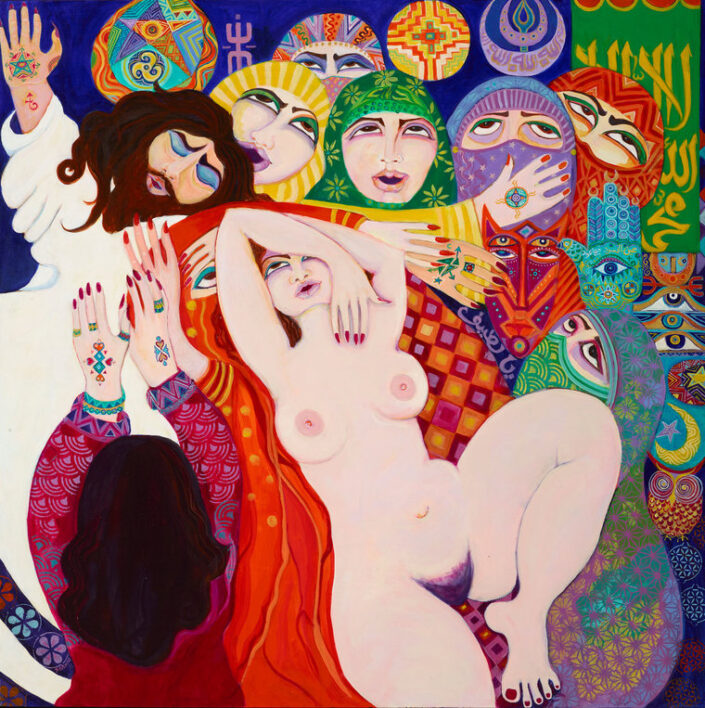


In essence, Laila Shawa’s artistic journey exemplifies the transformative power of creativity and advocacy, forging a path towards social change and empowerment. Her legacy serves as a beacon of hope, illuminating the transformative potential of art in challenging oppressive systems and fostering a more equitable world.
CV
Selected Solo Exhibitions
2012
The Other Side of Paradise, October Gallery, London, UK
2011
Trapped: A Female Suicide Bomber,Galerie Imane Farès, Paris, France
2010
Sarab (Mirage),The Art Museum, Sharjah, UAE
Arabopop, Articulate Baboon Gallery, Cairo, Egypt
2008
Sarab (Mirage),Atrium Gallery, DIFC, Dubai, UAE
2000
In the Name of God: Crucifixion 2000, Ashmolean Museum, Oxford, UK
1994
The Walls of Gaza Series II,The Library, SOAS, University of London, London, UK
1992
Women and Magic, The Gallery, London, UK
1990
Women and the Veil,Jordan National Gallery, Amman, Jordan
1975
Of Horses and Cities,L’Antiquaire Gallery, Beirut, Lebanon
1972
Exhibition at Sultan Gallery, Kuwait City, Kuwait
1971
Cities of Gold,Dar Tunis, The Tunisian Cultural Centre, Beirut, Lebanon
1970
Laila Shawa at the Vendome, Hotel Vendome, Beirut, Lebanon
1968
Exhibition of drawings by Laila Shawa, The Book Centre Gallery, Beirut, Lebanon
1965
Contrast and Difference,Marna House, Gaza, Occupied Palestine
Selected Group Exhibitions
2019
Dream No Small Dream: Celebrating 40 Years of the Transvangarde, October Gallery, London, UK
2011
Passport to Palestine,La Scatola Gallery, London, UK
Contemporary Art/Arab & Iranian, Sotheby’s, London, UK
2010
Miragens: Contemporary Art in the Islamic World, Centro Cultural Banco do Brasil, Rio de Janeiro, touring to Sao Paolo, Brasilia, Brazil
2010
Sajjil, A Century of Modern Art, Mathaf, Arab Museum of Modern Art, Doha, Qatar Co-incidence, Galerie Imane Farès, Paris, France
Crunchtime: Artist’s Responses to the Global Crisis, International Visual Arts Event, York, UK
2009
Contemporary Calligraphic Art from the Arab World, Nabad Gallery, Jabal Amman, Jordan
2009
Middle Eastern and European Art, the Recessionists, Somerset, UK
Arabesque:Arts from the Arab World, the Kennedy Centre, Washington, DC, USA
2008
Arab Print,Edition I, Meem Gallery, Dubai, UAE
Routes, Middle Eastern and Arab Art, Waterhouse & Dodd, London, UK
Roads Were Open, Roads Were Closed,Third Line Gallery, Dubai, UAE
Mediterraneo, Italian Cultural Institute, London, UK
Spring Show, October Gallery, London, UK
Word into Art, a British Museum touring exhibition, The Atrium, DIFC, Dubai, UAE
2006
Word into Art,British Museum, London, UK
Text Messages,October Gallery, London, UK
2005
Walled In: Walled Out,Laila Shawa and Noa Lidor, Green Cardamom, London, UK
2003
Religion, Art and War, Maison Des Artes, London, UK
Transvangarde: Contemporary Art from Around the World, (October Gallery), Kulturbrauerei, Berlin, Germany
2002
Breaking the Veils: Women Artists from the Islamic World, exhibition organised by the
Royal Society of Fine Arts, Jordan, and Pan-Mediterranean Women Artists Network F.A.M. (Femme- Artist-Méditerranée) based in Greece which travelled throughout Europe, Australia and USA
Between Legend and Reality, Modern Art from the Arab World,Reykjavik Art Museu and Akureyri Art Museum, Iceland
From the Ocean to the Gulf and Beyond: Arab Contemporary Art,the Jordan National Gallery of Fine Arts, Amman, Jordan
A Thousand Ways of Being. Memory and Presence in the Arts of Diasporas, October Gallery, London, UK
Masterstrokes:Contemporary Arabic Calligraphy, October Gallery, London, UK
Transvangarde, An Artistic World Wide Web, October Gallery, London, UK
2001
Twelve Arab Artists,Wereldmuseum, Rotterdam, the Netherlands
1998-2000
Art Beyond Borders,UNESCO and TIMOTCA (The International Museum of Twentieth Century Art); UNESCO Headquarters, Paris, France; Mitra Municipal Gallery, Lisbon, Portugal; Las Vegas Art Museum, USA
2000
First International Forum for a Culture of Peaceby Pan-Mediterranean Women Artists Network, Rhodes, Greece
1990-2000
Dialogue of the Present,Hot Gallery, Bath; Plymouth Arts Centre, Plymouth; Brunei Gallery, SOAS, London; Pittshanger Manor Gallery, London; Brighton University Gallery, Brighton, UK
1998
Mediterranea,Grand Palais, Brussels, Belgium
1997
Artistes palestiniens contemporains, Institute du Monde Arabe, Paris, France
1996
Transvangarde, October Gallery, London, UK
Contemporary Arab Artists, the World Bank Gallery, the World Bank Building, Washington DC., USA
The Right to Write: Calligraphic Works from the Collection of the Jordan National Gallery of Fine Arts,The Dalton Gallery, Agnes Scott College, Decatur, Georgia, USA
1995-97
The Right to Hope, One World Art, UN travelling exhibition starting in Johannesburg, South Africa (whole exhibition was lost in Sarajevo 1997/8)
1995
Contemporary Middle Eastern Art, recent acquisition, John Addis Gallery, British Museum, London, UK
Artists’ View, The Arab World, Willamette Arts Gallery, Willamette University, Salem, Oregon, USA
1994–95
Forces of Change, Artists of the Arab World, National Museum of Women in the Arts, Washington, DC; Dudley House, Lehman Hall, Harvard University, Cambridge, MA; The Chicago Cultural Centre, Chicago Illinois; Wolfson Gallery and Central Gallery, Miami
Dade Community College, Miami Florida; Nexus Contemporary Art Centre, Atlanta, Georgia; Bedford Gallery,Walnut Creek, California; Gwinnett Arts Center, Duluth, Georgia, USA
1994
Shawa and Wijdan, October Gallery, London, UK
From Exile to Jerusalem,Al-Wasiti Art Centre, Jerusalem
1993
Exhibition of Limited Prints Editions at SAGA, Salon de l’estampe et de l’édition d’art à Tirage limité, Grand Palais, Paris, France
1992
Three Artists from Gaza: Fayez Al Hasani, Kamel al Mughanni and Laila Shawa,The Shoman Foundation, Amman, Jordan
1990
Malaysian Experience, National Art Gallery of Malaysia, Kuala Lumpur, Malaysia
1989
Contemporary Art from the Islamic World, Barbican Centre, London, UK
1988
The Baghdad Biennale,Saddam Centre, Baghdad, Iraq
1987
Arab Women Artists in the UK, Kufa Gallery, London, UK
1968-78
With Palestinian Union of Artists, based in Beirut, exhibitions in most Arab countries, North Africa, Russia, China, Japan, Malaysia, Europe, UK and USA
Collections
The National Art Gallery, Kuala Lumpur, Malaysia
Jordan National Gallery of Fine Arts, Amman, Jordan
British Museum, London, UK
Museum of Modern Art, Glasgow, Scotland The Arab Bank Limited, Amman, Jordan
The Palestinian Union of Artists, Beirut, Lebanon
The Kuwait Fund, Kuwait City, Kuwait
Rashad Shawa Cultural Centre, Gaza, Palestine
The Birzeit University collection, Ramallah, Occupied Palestine
The Khaled Shoman Foundation: Darat Al Funun, Amman, Jordan
National Museum for Women in the Arts, Washington DC, USA
Qatar Museum for Contemporary Middle Eastern Art, Mathaf, Qatar
Wereldmuseum, Rotterdam, the Netherlands
TIMOTCA, Las Vegas, USA
World of Islam Festival Trust, London, UK
Ashmolean Museum, Oxford, UK
The Burrell Collection, Art Gallery and Museum, Glasgow, Scotland
DIFC, Dubai, UAE
Spazio Brazzà, Moruzzo, Italy
The Benevolent Society, Gaza, Palestine
Ramzi and Saeda Dalloul Art Foundation, Beirut, Lebanon
Barjeel Art Foundation, Sharjah, UAE
Sources
Samina Ali, “The Political is Personal: An Interview with Palestinian Artist Laila Shawa,” Muslima online, muslima.globalfundforwomen.org
“Laila Shawa,” October Gallery website, octobergallery.co.uk
Helen Khal, The Woman Artist in Lebanon,Catholic Press, Lebanon, 1987
Wijdan Ali, Contemporary Art from the Islamic World, Scorpion Books, London, UK, 1988 Shammout, Ismail. Art in Palestine, AI Qabbas Press, Kuwait 1989
Laila Shawa, Works 1965- 1994 AI-Hani Books, 1994
Forces of Change, Artists of the Arab World, Washington D.C., USA, 1994
Bahnasi, Dr. Afif, Pioneers of Modern Art in the Arab Countries,Dar Al-Raed Al-Arabi, Beirut. Shawa and Wijdan, October Gallery,1994, Amica Press.
The Right to Hope,Earthscan Publications Ltd., 1996, London
Impressions,H. Aschehoug & Co., 1996, Norway.
The Right to Write,Agnes Scott College, Atlanta, USA.
Artistes Palestiniens Contemporains,Institute Du Monde Arabe, 1997, Paris, France.
The Space Between Our Footsteps,Simon & Schuster, 1998.
Dialogue of the Present,Woman’s Art Library, 1999.
Mediterranea,Art Life 1998, Brussels, Belgium.
Twelve Arab Artists,The Werled Museum, 2001, Netherlands.
Between Legend and Reality, Aurora Art Museum, Reykjavik Art Museum Iceland 2002.
From the Ocean to the Gulf and Beyond: Arab Modern Art, The Royal Society of Fine Arts, 2002, Amman, Jordan.
Breaking the Veil,The Jordan National Gallery and FAM, 2002 Rhodes, Greece.
Word into Art, The British Museum 2006/.2008
Meditarraneo, A Sea that Unites,The Italian Cultural Institute, London 2008.
Sarab,DIFC, Dubai 2008.
Impossible Dreams: the Qork and Art of Laila Shawa,SkIRA Books, Milano, 2009
Contemporary Art in The Middle East, ArtWorld, Black Dog Publishing, London, UK, 2009.
